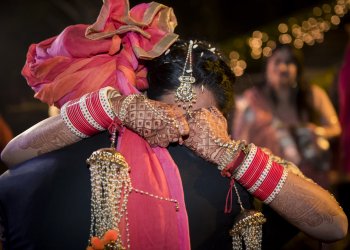If you attend a Hindu wedding you could see the bride and groom exchanging prodigious flower garlands. The couple would carry the garland throughout the ceremony even it is too heavy or uncomfortable. Why do they implement such strenuous rituals during the wedding day, when it is already too laborious? The Var mala ceremony is too indispensable for a Hindu wedding, it is the one common ritual found in all Hindu wedding, irrespective of the caste, geography, language or cultural differences. Read on to discern the significance of Var mala ceremony at a Hindu wedding.

The ritual of Var mala also known as Jaimala is an integral part of wedding ceremonies since the Vedic period. For the Var mala ritual, the bride and groom exchange garland and they lay the mala on each other’s neck. Traditionally the var mala is composed of flowers, leaves, lemon, beads, and sometimes silk cloth. The most common flower used in var malas are the roses followed by jasmine, marigold or orchids. Different flowers and colors indicate different values and emotions. For instance, the pink roses indicate the happiness that is going to come to the couple’s life whereas the red roses indicate true love and orange roses signifies passion. The jasmine represents good luck, the marigold represents prosperity, and orchids indicate magnificence.
The Var mala ceremony is after the baraat or the procession of the groom and his relatives. The bride will wait in the mandap or the stage for the groom to enter. The bride puts the garland on the groom once he enters the mandap signifying her acceptance of the groom as her husband. The husband reciprocates the gesture by placing the garland on the bride accepting her as his wife. The ceremony is performed in the presence of family, friends, and the priest; they often shower their blessing in the form of flowers over the couple after the exchange. The priest enchants the Sanskrit mantras during the ceremony to invoke the blessings of the almighty and to keep the bond between the husband and wife strong and long-lasting.
The exchange of garland or the var mala is an equivalent to the exchange of vows and the ‘I do’ ceremony of Christian weddings. Instead of the words ‘I do’ the couple lowers their neck and accepts the garland of extended by the other as a way of saying ‘I do’. The ceremony also depicts that the couple is equal in holy matrimony and it represents the affection between the bride and groom.
As the exchange of Var mala is significant in Hindu marriage ceremony, it is the moment which is photographed and cherished the most after the Mangalsutra ceremony. A Hindu wedding is incomplete without the exchange of Var malas.
When you are choosing a Var mala, choose the flowers and the colors according to the values you wish to uphold and highlight for your wedding and for the rest of your lives as a married couple.






















